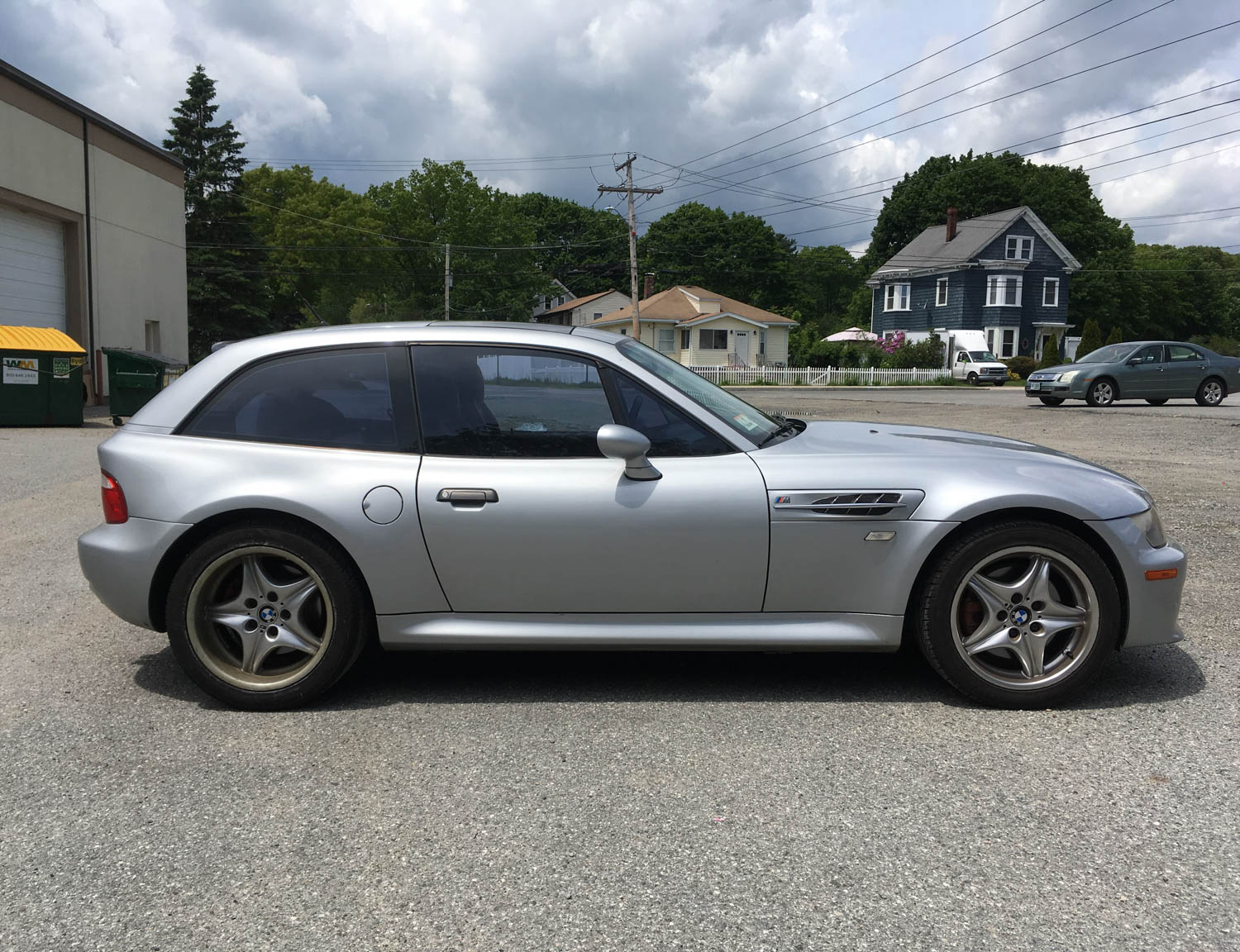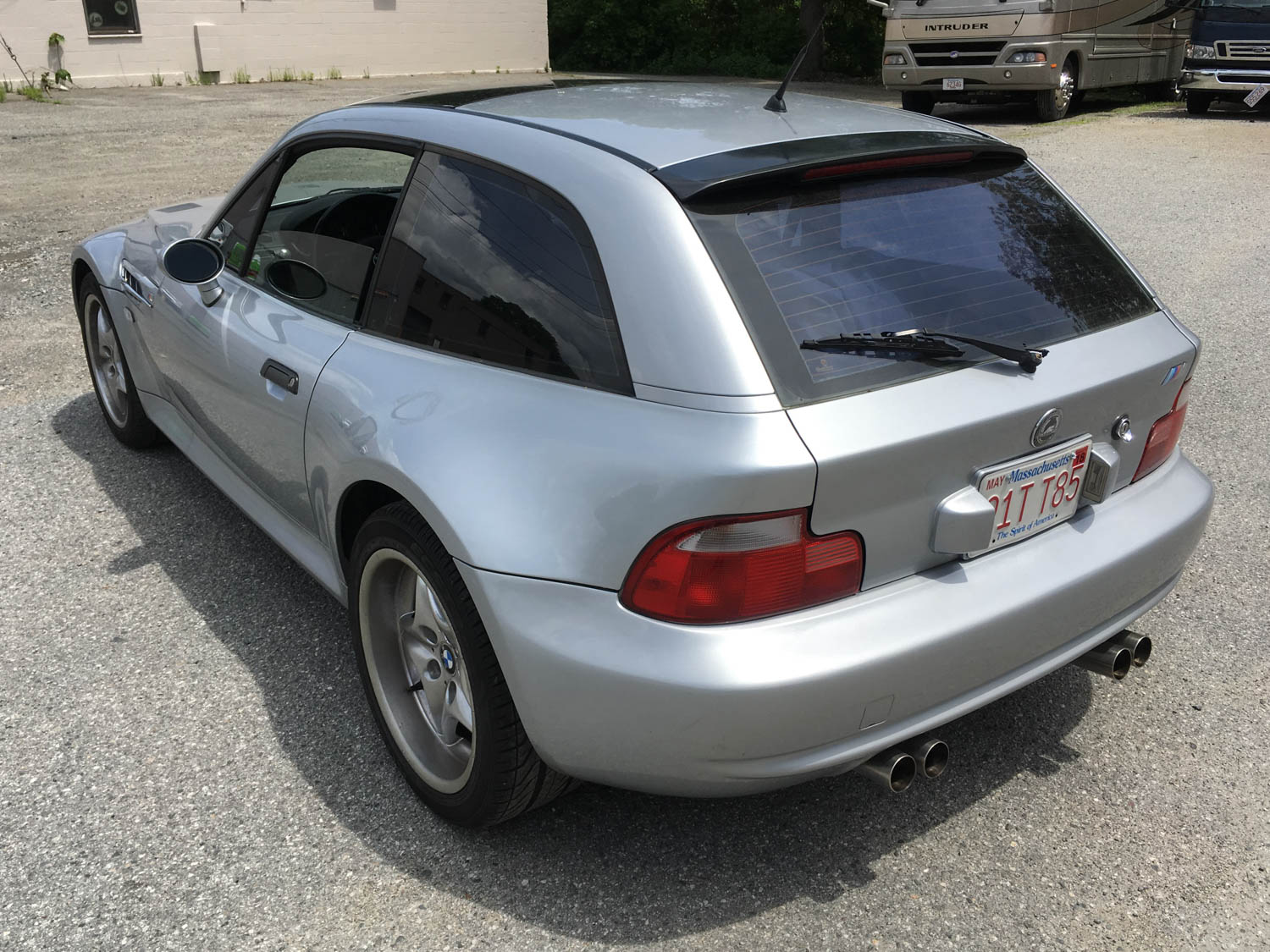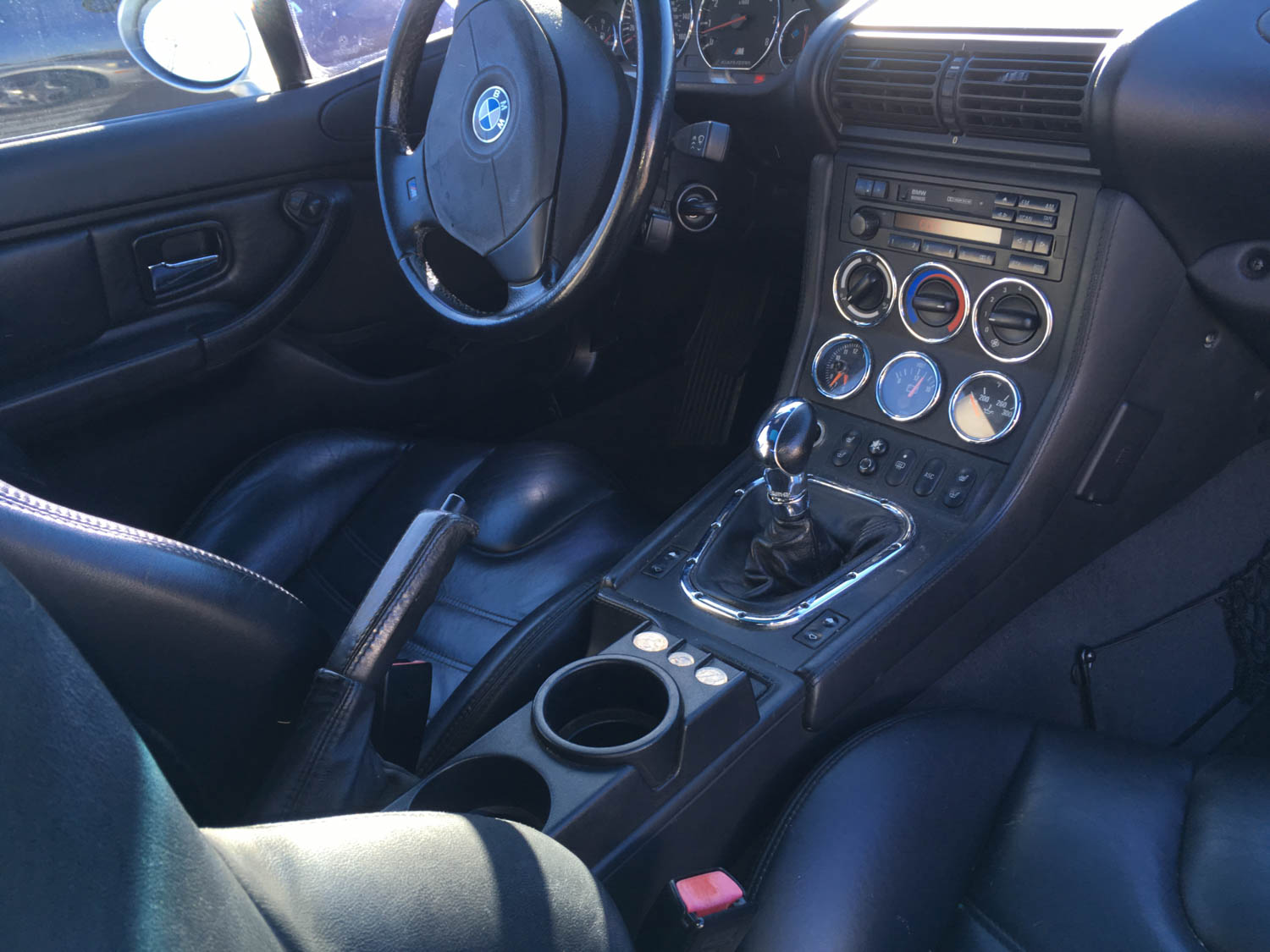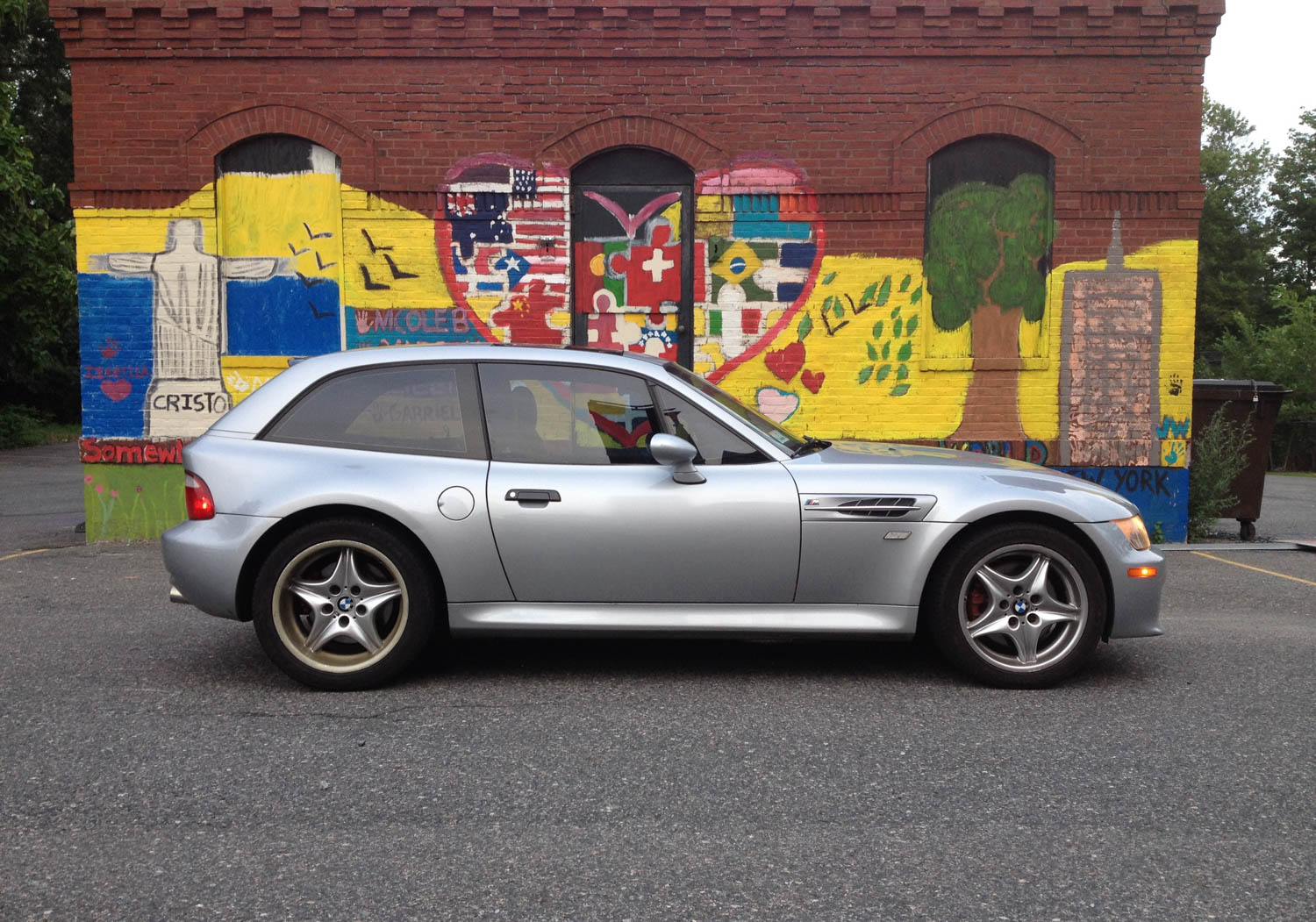For something completely different, send in the Clown Shoe
As you probably know from reading this space, my passions are channeled mainly toward 1970s-era BMWs (my recently-resurrected Lotus Europa Twin-Cam Special notwithstanding). However, there is another outlier in the Siegel stable that elicits a lot of passion from me and stares from strangers, and that’s the “Clown Shoe”—my 1999 BMW M Coupe.
To explain the M Coupe—also called a Z3 M Coupe—we need to start with the regular Z3. Most people are familiar with the little Z3 roadster BMW sold in the United States from 1996–2002. The Z3’s chassis is based on the 1992–99 BMW E36 3 Series sedan. However, for reasons of cost, space, and simplicity, Z3s don’t have the E36’s multilink rear end; instead, BMW used the simple rear trailing arm suspension from the earlier E30 3 Series. Because of this, Z3s don’t have the self-correcting capability of the E36, where if you head into a curve a little too hot and correct the steering, the rear end just snaps back into line. But as long as you don’t do anything stupid on unfamiliar entrance ramps, it’s fine, and it makes the car feel light, direct, and nimble. The first Z3s had a 138-horsepower four-cylinder engine that you needed to put your foot into, but in 1998, that gave way to the first of four straight-sixes. Even the smallest one, which was badged as a 2.3 but is actually 2.5 liters, put out 170 hp and 181 lb-ft of torque, giving it plenty of grunt for a little 2800-pound car.
The styling of the Z3 is a little, well, bulbous. Those of us who grew up on ’60s and ’70s roadsters and coupes with flat, wide hoods find the Z3’s nose a little comical, like it was drawn for Who Framed Roger Rabbit. It was more cute than it was knee-weakening. I never loved the look, but when I was in the market for an inexpensive roadster a few years back and drove a base-model 1999 2.3 Z3, I instantly liked it and bought it. Hey, I’m a BMW guy. This is a 20-year-old roadster that you can now buy for $4000–$5000. If you prefer a Porsche Boxster, or a Miata, or a Honda S2000, more power to you; they’re all great cars.

As with every model of the 3 Series since the E30, the Z3 had an “M” variant. It couldn’t be an M3, as the sedan was already so-named, so its official name was the “M Roadster.” It was sold in model years 1999–2002 and had the hot engine from the M3 sedan, stiffer suspension, staggered wheels including deep-dish rears, little side skirts, and other swag. Because the Z3 straddled production of the E36 and E46 M3 sedans, the early (1999 and 2000) M Roadster got the 240-hp S52 motor from the E36 M3, but the late ones (2001 and ’02) received the more-powerful, higher-revving S54 engine from the E46 M3. In the M3, the S54 engine is rated at 330 hp, but in the M Roadster, it’s quoted at 315 hp due to a lower redline and a different exhaust and ECU. With either engine, the M Roadster is, as they say, a bit of a handful, since the wheelbase is short. And that old-school semi-trailing arm rear end can get you into trouble if you corner too hot.
But enough about Z3s and M Roadsters. We’re only talking about them because that’s where the M Coupe grew from.

Most convertibles and roadsters begin their life as a coupe that loses its roof. Changes to the design and modifications to the body structure must be made in order to regain the structural rigidity that’s lost when the roof and its six supporting pillars are removed. In contrast, the Z3 was designed as a roadster and thus was already stiffened. So when a roof was added for the coupe, it added even more stiffness to an already stiff design. Project manager Burkhard Goeschel reportedly wanted to build the coupe version of the roadster, had his team design and built one on the sly, then presented the prototype to management. Their response was, apparently, less than enthusiastic, but he was reportedly given the green light as long as project costs were kept in line. The skunk-worked nature of the car explains why it looks like two different cars from the front and back (something it has in common with my Europa).
When the car was introduced, the design was polarizing. With its high back and low nose, the Germans called it “turnschuh” (running shoe). In this country, “clown shoe” is the mostly-endearing term. As a new car, it didn’t sell well, thus few were produced. But over time, much of that polarization has given way to acceptance. It’s a unique-looking car that can’t be mistaken for anything else on the road. I’ve grown to love how the bulbous nose is dominated by the back end of the car, which is itself an odd combination of graceful fender lines combined with the squared-off roof and hatch. Surprisingly, for something that was an add-on as opposed to a holistic design, it all works. If you own one, you love it. If you don’t, and see one while driving, you can complain about it as it eats your lunch.

On the one hand, because of the vertical rear door of the hatchback-converted car, it’s often referred to as an example of a “shooting brake” in the European tradition, so-named because originally such vehicles were used to transport the shotguns and release the hounds (think Volvo P1800 sport wagon). On the other hand, I doubt you’d fit even a single shotgun and a solitary hound in the M Coupe. Maybe a small hound. (Or, to channel Maxwell Smart, would you believe a schnauzer and a water pistol?) The M Coupe is too little to be considered a real hatchback, and certainly too short to be a two-door wagon. Any chance of real cargo space under the hatch got usurped by a silly bulkhead that houses a power amp, subwoofer, and pull-across shade. The car is more reminiscent of classic little British fastback hatchbacks like the MGB GT or Triumph GT6, but with a vertical hatch as a design element invoking a shooting brake without actually being one.
But the M Coupe is unique and audacious. Those rear fender flares, combined with the fat rubber and hatch, make the rear end of the car look planted. And with the M engine, tight shifter, and stiff suspension, the car just seems to whisper in your ear to do bad things, like that crazy risk-taking friend in high school your parents really were right about.

M Coupes are, for a non-homologation car from a volume manufacturer like BMW, rare. A total of 2870 were built for the U.S. market. That breaks down into 2180 S52 cars and a scant 678 S54 cars. With numbers this low and gawk factor and performance this high, it’s not surprising why media outlets are falling over each other declaring them the next air-cooled Porsche. Pristine low-mileage 2001–02 S54 cars in dramatic colors command a premium, with recent sales of $92,000 (for one with 4000 miles) and $89,000 (9000 miles) on Bring a Trailer. Excellent driver-quality S54 cars trade roughly in the $25,000–$50,000 range. With the rarity and horsepower chips on its shoulder, the S52 cars fetch less money.
Frankly, I think the whole S52/S54 engine thing has gotten out of hand. BMW’s official 0–60 numbers are 5.3 seconds for the S52 car and 4.8 seconds for the S54 car, creating a sounds-significant difference of half a second. However, when the cars were new, some reviewers clocked the S52 car as low as 5.0 seconds, making the differential pretty small. The low-mileage S54 cars are generating all the heat and light in the marketplace, but S54 engines do have some maintenance issues. At minimum, they’re solid-lifter engines whose valve adjustment is accomplished via the use of shims. In addition, there are known rod-bearing issues due to the long crank and high redline. In contrast, the S52 motor, though maligned by some diehard E36 M3 enthusiasts due to its North America-only designation, is fairly bulletproof and utilizes hydraulic lifters. Yes, with so few S54 cars, deep-pocketed collectors are driving up the prices. So what else is new? The rest of us have to live on a budget. The S52 cars are a much better value and are plenty quick.

Note that there is also a non-M Z3 Coupe and 2071 were built for the American market. They’re fine cars, but they lack the M engine and suspension and the fat, planted rear stance of their M brother.
My car is a 1999 (S52), in the fairly common color combination of Arctic Silver with a solid black interior. M Coupes were available in some zingy colors with matching or contrasting two-tone interiors. Personally, I think the lines of the car are so extreme that colors like silver, which soften those lines, work well. Similarly, the interior, which features a classic BMW dashboard but with chrome-rimmed gauges that hint of 1960s hot rod, doesn’t need garish inset color panels. Silver and solid black looks great. With that said, I’m sure if I had an Imola Red car with red/black panels, I’m sure I’d love it just as much.

I bought my S52 12 years ago. Like many purchases, it was a crime of opportunity. I saw it on Craigslist in southern Massachusetts in the dead of winter for a good price. It was not garaged. It was daily-driven into Boston by an unlikely owner, a guy who worked in the financial district and simply liked the way the car looked. I took it for a test drive, and even with bent wheels and seized and blown shocks and struts, was instantly smitten. I reached the entrance ramp, nailed it in second gear, shifted through third, and by the time I slotted it into fourth, I was surprised to find myself doing nearly 90 mph. When I bought it, I still had my ’82 Porsche 911SC, so having two two-seater slot cars was utterly frivolous, but I bought it anyway.
When my engineering job became unstable about seven years ago and I lost my free storage space, I needed to shed some cars. I’d already owned the 911SC for 10 years, and decided it was time to move it along. The timing was terrible; I had no way to know that it was right before the big run-up in air-cooled 911 prices. While that’s a decision I deeply regret, it was either that or the M Coupe, and fundamentally, the SC felt like another vintage car (of which I still had several) while the M Coupe felt like nothing else I owned, so it stayed. Financially, I would’ve made out better had I kept the SC and sold the M Coupe, but passion-wise, it was the right choice. I daily drove the M Coupe to work in good weather until I put it on my Hagerty policy about five years ago.

I do have some complaints about the car. I find the heavily-bolstered seats uncomfortable for long drives. It’s surprising because I have had similar-looking vintage Recaros, Konigs, and Flofits in many cars, and they provide ample lower back support, but the padding in the M Coupe’s seats is so firm that it doesn’t conform well to my lower back or my butt, and driving the car for over an hour is painful. I can mitigate this using a TempurPedic back cushion, but the seats are so narrow that this is awkward.
Although the car is a blast to drive fast, you can, as I’ve said, get yourself into trouble. Other BMW M cars are point-and-squirt; aim it where you want with two fingers on the wheel and hit the gas. Your grandmother could drive them hard. But the M Coupe is very different. The combination of the E30 semi-trailing arm rear end and a relatively quick steering box makes oversteer a definite possibility if you’re pushing it too hard around unfamiliar cloverleafs.
The bracket that suspends the differential from the body has a tendency to crack. Reportedly the problem is more prevalent among cars that have been tracked, but it can happen to any car. Reinforcement kits are available, but welding is required.
Rattles are a known issue. The stiff body shakes things to death. The cheaply-made glovebox is known for self-destructing, requiring removal and reinforcing with nuts, bolts, and hot glue. The ridiculous bulkhead that holds the subwoofer can also be a nest of rattles and creaks.
Like any BMW built after the early 1990s, there’s a lot of plastic in the cooling system. If the car’s maintenance history isn’t known, prophylactic replacement of the water pump, thermostat and housing, radiator, and expansion tank is advised.
The doors are the same as other Z3s, but the door windows and regulators are unique to the coupe. As with other BMWs of the era, the regulators break, and during replacement, adjustment of the frameless windows is challenging. Further, the unique geometry of the windows on the coupe results in the window regulator putting stress on the mounting points inside the door, often cracking or breaking them.
The car comes with no spare tire. With those fat staggered dished wheels and that tiny hatch, there’s no room. When the cars were new, they came with BMW Roadside Assistance that would tow you to a dealer. I bought a donut spare and the correct scissor jack and brought it whenever I drove farther than AAA/Hagerty towing distance. Still, even that ate up much of the room under the back hatch.

Although I don’t drive the M Coupe often these days, whenever I think about selling it, I’m terrified there’ll be a repeat performance of when I sold the 911SC years back, right before the big run-up in prices. But whenever I drive it, I smile instantly and want to do donuts in parking lots. It is completely unlike anything else I own. And, crucially, whenever I bring up the topic of what to sell, my wife says, “Well, you can’t sell the M Coupe.”
So do something silly. Slip on a clown shoe. Not everything in this world needs to make sense.

***
Rob Siegel has been writing the column The Hack Mechanic™ for BMW CCA Roundel magazine for 33 years and is the author of five automotive books, including Just Needs a Recharge: The Hack Mechanic™ Guide to Vintage Air Conditioning. All of his books are available on Amazon. You can also order personally inscribed copies here. Siegel’s new book, Resurrecting Bertha: Buying Back the Car My Wife and I Drove Off From Our Wedding, will be released later this year.


